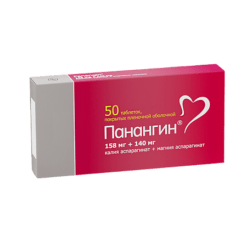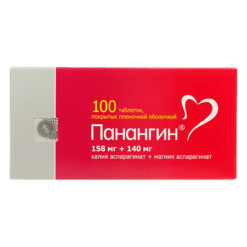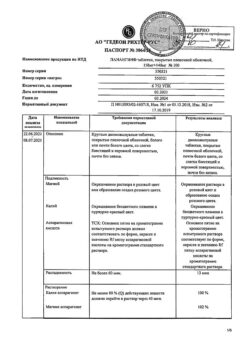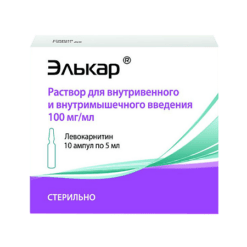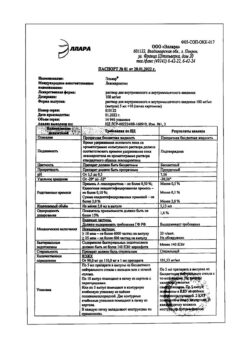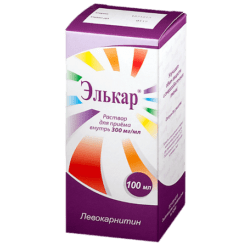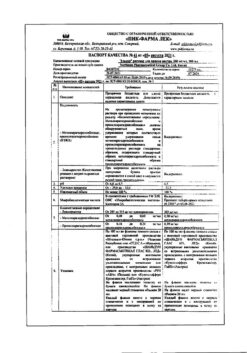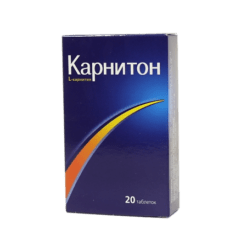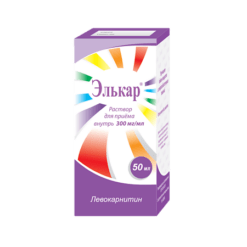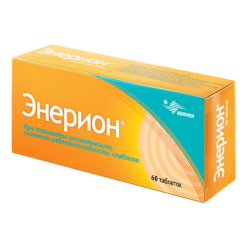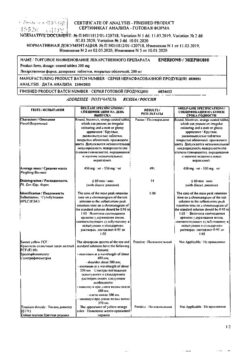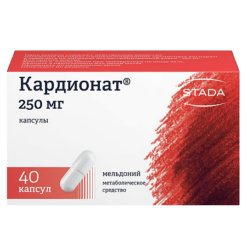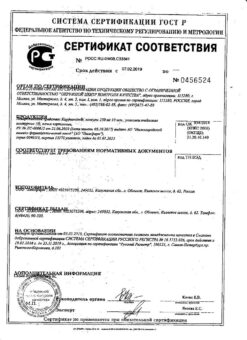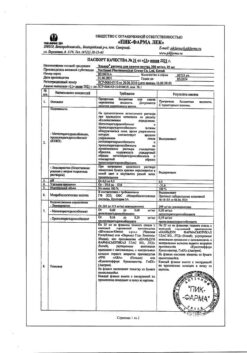No products in the cart.
Panangin, concentrate 45.2 mg/ml+40 mg/ml 10 ml 5 pcs
€5.33 €4.74
Out of stock
(E-mail when Stock is available)
Description
Pharmacotherapeutic group: potassium and magnesium drug.
ATC code: A12CX
Pharmacological properties
Panangin is a source of important electrolytes: potassium and magnesium ions. One of the most important functions of potassium ions is to maintain the membrane potential of neurons, myocytes and excitable structures of myocardial tissue. An imbalance between intracellular and extracellular potassium results in decreased cardiac contractility, arrhythmias, tachycardia and increased toxicity of cardiac glycosides.
Magnesium is an important cofactor of over 300 enzymatic reactions, including energy metabolism and the synthesis of proteins and nucleic acids. In addition, magnesium plays an important role in heart function: it improves contractility and heart rate, resulting in lower myocardial oxygen requirements.
Decreasing the contractility of arteriolar smooth myocytes leads to vasodilation, including of coronary vessels, and increases coronary blood flow. Magnesium has an anti-ischemic effect on myocardial tissue.
The combination of potassium and magnesium ions in one product is based on the fact that potassium deficiency in the body is often accompanied by magnesium deficiency and requires simultaneous correction of the levels of both ions. Further, if the levels of these electrolytes are corrected simultaneously an additive effect is observed (low levels of potassium and/or magnesium have a proarrhythmogenic effect). In addition, potassium and magnesium reduce the toxicity of cardiac glycosides without affecting the positive inotropic effect of the latter.
Pharmacokinetics
No data.
Indications
Indications
To eliminate potassium and magnesium deficiency as an adjuvant for various manifestations of coronary heart disease, including acute myocardial infarction; chronic heart failure; heart rhythm disturbances (including arrhythmias caused by an overdose of cardiac glycosides).
Pharmacological effect
Pharmacological effect
Pharmacotherapeutic group: potassium and magnesium preparation.
ATX code: A12СХ
Pharmacological properties
Pharmacodynamics
Panangin is a source of important electrolytes: potassium and magnesium ions. One of the most important functions of potassium ions is to maintain the membrane potential of neurons, myocytes and excitable structures of myocardial tissue. An imbalance between intracellular and extracellular potassium leads to a decrease in cardiac contractility, arrhythmia, tachycardia and increased toxicity of cardiac glycosides.
Magnesium is an important cofactor in more than 300 enzymatic reactions, including energy metabolism and the synthesis of proteins and nucleic acids. In addition, magnesium plays an important role in the functioning of the heart: it improves contractility and heart rate, leading to a decrease in myocardial oxygen demand.
A decrease in the contractility of smooth myocytes of arterioles leads to vasodilation, including of the coronary vessels, and to increased coronary blood flow. Magnesium has an anti-ischemic effect on myocardial tissue.
The combination of potassium and magnesium ions in one preparation is based on the fact that potassium deficiency in the body is often accompanied by magnesium deficiency and requires simultaneous correction of the levels of both ions. Further, with simultaneous correction of the levels of these electrolytes, an additive effect is observed (low levels of potassium and/or magnesium have a proarrhythmogenic effect), in addition, potassium and magnesium reduce the toxicity of cardiac glycosides without affecting the positive inotropic effect of the latter.
Pharmacokinetics
No data available.
Special instructions
Special instructions
With rapid administration, skin hyperemia may develop.
Particular caution should be exercised in the presence of diseases accompanied by hyperkalemia. In these cases, it is recommended to monitor the content of potassium ions in the blood.
Active ingredient
Active ingredient
Potassium aspartate, Magnesium aspartate
Composition
Composition
Active substances:
Potassium aspartate (as potassium aspartate hemihydrate) 452 mg (corresponding to 103.3 mg potassium ions),
magnesium aspartate (in the form of magnesium aspartate tetrahydrate) 400 mg (corresponding to 33.7 mg magnesium ions);
Excipients: water for injection – up to 10 ml.
Pregnancy
Pregnancy
There is no data on the harmful effects of the drug during pregnancy.
Contraindications
Contraindications
Hypersensitivity to the drug, acute and chronic renal failure; Addison’s disease; atrioventricular block II, III degree; cardiogenic shock (blood pressure Use caution
First degree atrioventricular block, severe liver dysfunction; metabolic acidosis; risk of edema; impaired renal function if regular monitoring of the magnesium content in the blood serum is impossible (danger of accumulation, toxic magnesium content); cardiogenic shock (systolic blood pressure less than 90 mm Hg); hypophosphatemia; urolithiasis associated with impaired metabolism of calcium, magnesium and ammonium phosphate.
Side Effects
Side Effects
With rapid intravenous administration, symptoms of hyperkalemia (fatigue, myasthenia, paresthesia, confusion, cardiac arrhythmia (bradycardia, atrioventricular block, arrhythmias, cardiac arrest) and hypermagnesemia (decrease in neuromuscular excitability, retching, vomiting, lethargy, decreased blood pressure) and hypermagnesemia (decrease in neuromuscular excitability, retching, vomiting, lethargy, decreased blood pressure) may develop. atrioventricular block and paradoxical reaction (increased number of extrasystoles).
Interaction
Interaction
Strengthens the negative dromo- and bathmotropic effects of antiarrhythmic drugs.
Eliminates hypokalemia caused by glucocorticoids.
Due to the magnesium content, it reduces the effect of neomycin, polymyxin B, tetracycline and streptomycin. Cyclosporine, potassium-sparing diuretics, heparin, ACE inhibitors may increase the risk of hyperkalemia.
Anesthetics enhance the inhibitory effect of magnesium on the central nervous system.
May enhance neuromuscular blockade caused by depolarizing muscle relaxants (atracurium besilate, decamethonium bromide, suxamethonium (chloride, bromide, iodide)).
Calcitriol increases the concentration of magnesium in the blood plasma, calcium preparations reduce the effect of magnesium.
Beta-blockers and non-steroidal anti-inflammatory drugs increase the risk of developing hyperkalemia up to the development of arrhythmia and asystole.
Pharmaceutically compatible with solutions of cardiac glycosides (improves their tolerability, reduces the undesirable effects of cardiac glycosides).
Overdose
Overdose
To date, cases of overdose have not been described. In case of overdose, the risk of symptoms of hyperkalemia and hypermagnesemia increases.
Symptoms of hyperkalemia: fatigue, myasthenia gravis, paresthesia, confusion, cardiac arrhythmia (bradycardia, atrioventricular block, arrhythmias, cardiac arrest).
Symptoms of hypermagnesemia: decreased neuromuscular excitability, retching, vomiting, lethargy, decreased blood pressure (BP). With a sharp increase in the content of magnesium ions in the blood – depression of deep tendon reflexes, respiratory paralysis, coma.
Treatment: If symptoms of overdose occur, treatment with Panangin should be stopped and symptomatic therapy (intravenous administration of calcium chloride at a dose of 100 mg/min, hemodialysis if necessary).
Storage conditions
Storage conditions
Store at a temperature of 15 to 30 °C.
Keep out of the reach of children!
Shelf life
Shelf life
3 years. Should not be used after the expiration date!
Manufacturer
Manufacturer
PharmFirma Sotex, Russia
Additional information
| Shelf life | 3 years. Do not use after the expiration date! |
|---|---|
| Conditions of storage | Store at temperatures from 15 to 30 ° C. Keep out of reach of children! |
| Manufacturer | PharmFirm Sotex, Russia |
| Medication form | concentrate for preparation of infusion solution |
| Brand | PharmFirm Sotex |
Other forms…
Related products
Buy Panangin, concentrate 45.2 mg/ml+40 mg/ml 10 ml 5 pcs with delivery to USA, UK, Europe and over 120 other countries.


